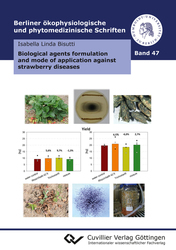| Departments | |
|---|---|
| Book Series (96) |
1378
|
| Nachhaltigkeit |
3
|
| Gesundheitswesen |
1
|
| Humanities |
2363
|
| Natural Sciences |
5406
|
| Mathematics | 229 |
| Informatics | 319 |
| Physics | 980 |
| Chemistry | 1363 |
| Geosciences | 131 |
| Human medicine | 243 |
| Stomatology | 10 |
| Veterinary medicine | 108 |
| Pharmacy | 147 |
| Biology | 835 |
| Biochemistry, molecular biology, gene technology | 121 |
| Biophysics | 25 |
| Domestic and nutritional science | 45 |
| Agricultural science | 1004 |
| Forest science | 201 |
| Horticultural science | 20 |
| Environmental research, ecology and landscape conservation | 148 |
| Engineering |
1791
|
| Common |
98
|
|
Leitlinien Unfallchirurgie
5. Auflage bestellen |
|
Advanced Search
Biological agents formulation and mode of application against strawberry diseases (Volume 47) (English shop)
Isabella Linda Bisutti (Author)Preview
Extract, PDF (230 KB)
Table of Contents, PDF (140 KB)
Biological plant protection products can be an important tool in integrated pest management. The production and formulation of micro-organisms to an applicable product are still a challenge. The final product is a compromise between biomass production, storage and efficacy capabilities. Often the performance depends from the testing system in fact antagonism showed in laboratory or controlled chambers can fail in the field. Therefore it is important to test biological plant protection products at the intended application environment. Also storage and efficacy tests should be made with the final product since the living organisms there contained can be influenced by the fermentation and the formulation processes. Cooperation between industry, science and farmers is needed to develop a product with stable results in time and different environments.
Die Entwicklung adäquater Produktions-, Formulierungs- und Applikationsmethoden ist ein fundamentaler Schritt bei der Vorbereitung von Bioprodukten für deren Vermarktung. Die meisten Wirksamkeitsstudien wurden in kontrollierten Umgebungen und ohne Formulierung durchgeführt, was zu Biopestiziden führte, welche eine inkonsistente Leistung im kommerziellen Bereiche zeigten und so das Vertrauen der Anwender in diese Produkte minderte. Kultivierungsmethoden beeinflussten das formulierte Endprodukt sowie die Formulierung, die Lagerfähigkeit und die Wirksamkeit.
Ein Ziel dieser Arbeit war es, den Beitrag des Gefriertrocknungsprozesses auf das Verhalten von Pseudomonas zu testen und festzustellen, ob die Fermentierungsbedingungen Einfluss auf das Überleben sowie die Wirksamkeit gefriergetrockneter Zellen eines ausgewählten P. fluorescens-Stammes haben. Weiterhin soll die Arbeit Aufschluss über die Anwendbarkeit von formulierten mikrobiellen Produkten im integrierten Pflanzenschutz und unter konkrete Bedingungen liefern.
| ISBN-13 (Hard Copy) | 9783736970328 |
| ISBN-13 (eBook) | 9783736960329 |
| Final Book Format | A5 |
| Language | English |
| Page Number | 174 |
| Lamination of Cover | matt |
| Edition | 1. |
| Book Series | Berliner ökophysiologische und phytomedizinische Schriften |
| Volume | 47 |
| Publication Place | Göttingen |
| Place of Dissertation | Humboldt Universität Berlin |
| Publication Date | 2019-06-24 |
| General Categorization | Dissertation |
| Departments |
Agricultural science
|
| Keywords | Biological agent / Biological control agent, Biopesticides, Bioproducts, Botrytis cinerea, Chemical pesticides, Compatibility studies, Cryo-protectant, Culture age / harvesting time, Dual culture, Efficacy / Performance, Fermentation condition, Freeze-dried cells, Freeze-drying process, Freezing temperature, German market, Greenhouse and field trials, Growth temperature, Integrated pest management, Major strawberry diseases, Metarhizium brunneum Ma43, Microbial antagonist, Microsclerotia, Organic farming, Phytophthora cactorum, Plant growth-promoting, rhizobacteria, Plant protection products, Pseudomonades, Pseudomonas fluorescens Pf153, RhizoVital® 42 fl., Shelf life, Soil-borne, Strawberry Trichostar®, Verticillium dahliae, Viability |








